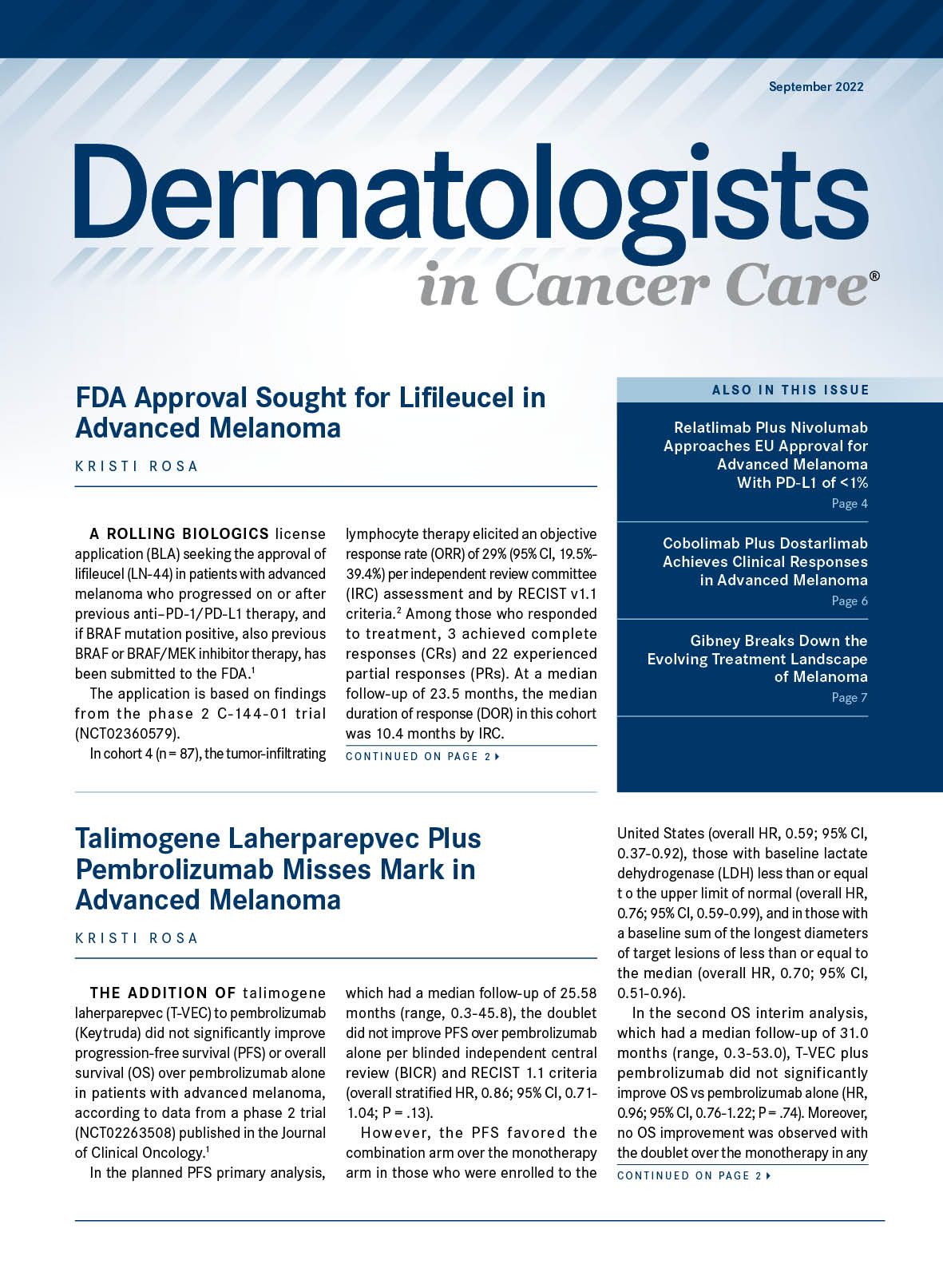Publication
Article
Supplements and Featured Publications
FDA Approval Sought for Lifileucel in Advanced Melanoma
Author(s):
A rolling biologics license application has been submitted to the FDA seeking the approval of lifileucel in patients with advanced melanoma who progressed on or after previous anti–PD-1/PD-L1 therapy, and if BRAF mutation positive, also previous BRAF or BRAF/MEK inhibitor therapy.
Frederick Vogt, PhD

A rolling biologics license application (BLA) seeking the approval of lifileucel (LN-44) in patients with advanced melanoma who progressed on or after previous anti–PD-1/PD-L1 therapy, and if BRAF mutation positive, also previous BRAF or BRAF/MEK inhibitor therapy, has been submitted to the FDA.1
The application is based on findings from the phase 2 C-144-01 trial (NCT02360579).
In cohort 4 (n = 87), the tumor-infiltrating lymphocyte therapy elicited an objective response rate (ORR) of 29% (95% CI, 19.5%-39.4%) per independent review committee (IRC) assessment and by RECIST v1.1 criteria.2 Among those who responded to treatment, 3 achieved complete responses (CRs) and 22 experienced partial responses (PRs). At a median follow-up of 23.5 months, the median duration of response (DOR) in this cohort was 10.4 months by IRC.
These data are supported by findings from cohort 2 (n = 66), in which lifileucel produced an ORR of 35% (95% CI, 23.5%-47.6%) per IRC; this included 5 CRs and 18 PRs. The median DOR was not yet reached at a median follow-up of 36.6 months.
In pooled patients from cohorts 2 and 4 (n = 153), lifileucel induced an ORR of 31% (95% CI, 24.1%-39.4%) by IRC. At a median follow-up of 27.6 months, the median DOR was not yet reached.
“Initiating our rolling BLA submission for lifileucel is a significant step toward our goal to deliver the first individualized, one-time cell therapy for melanoma patients with significant unmet need,” Frederick Vogt, PhD, JD, interim president and chief executive officer of Iovance Biotherapeutics, Inc., stated in a press release. “In parallel, we are executing our on-boarding and personnel training at authorized treatment centers, education and awareness initiatives, internal capacity planning, and launch readiness activities to prepare for commercialization. The FDA is supportive of our regulatory approach, and we look forward to continuing this collaboration throughout the submission and review process.”
The trial enrolled patients with unresectable or metastatic melanoma that was stage IIIC or IV who had confirmed radiologic progression.3 Patients must have progressed after 1 or more previous systemic therapies, including a PD-1 inhibitor, and if BRAF positive, a BRAF inhibitor with or without a MEK inhibitor.
Study participants received a nonmyeloablative lymphodepletion regimen comprised of cyclophosphamide at 60 mg/kg once daily for 2 days followed by fludarabine at 25 mg/m2 once daily for 5 days. Lifileucel was thawed and administered as a single infusion about 24 hours from the last dose of fludarabine. A short course of bolus interleukin-2 at 600,000 IU/kg was infused every 8 to 12 hours for up to 6 doses, starting within 3 to 24 hours of completing the infusion.
The primary objective of the trial was investigator-assessed objective response rate using RECIST v1.1 criteria. Secondary end points comprised DOR, overall survival, and safety.
Patients in cohort 4 were noted to have higher disease burden at baseline vs those in cohort 2.2 For example, a substantially higher proportion of patients had elevated lactate dehydrogenase levels at baseline in cohort 4 vs cohort 2, at 64.4% and 40.9%, respectively, and more baseline tumor lesions, at 83.9% vs 65.2%, respectively.
Those in cohort 2 also had about half of the cumulative duration of PD-1 therapy prior to lifileucel vs those in cohort 4; a reduced duration of previous PD-1 therapy was linked with an increase in DOR with lifileucel.
Regarding safety, the treatment-emergent adverse effects experienced in both cohorts were noted to align with the underlying disease and the known safety profiles of nonmyeloablative lymphodepletion and IL-2. Safety findings also proved to be consistent between cohorts 4 and 2.
Iovance shared plans to present additional data from C-144-01 at a medical conference later this year.
References
- Iovance Biotherapeutics initiates biologics license application (BLA) submission for lifileucel in advanced melanoma. News release. Iovance Biotherapeutics, Inc. August 25, 2022. Accessed August 25, 2022. https://bit.ly/3QSNyR1
- Iovance Biotherapeutics announces positive clinical data for lifileucel in advanced melanoma. News release. Iovance Biotherapeutics, Inc. May 26, 2022. Accessed August 25, 2022. https://bit.ly/3RdbWMG
- Sarnaik AA, Hamid O, Khushalani NI, et al. Lifileucel, a tumor-infiltrating lymphocyte therapy, in metastatic melanoma. J Clin Oncol. 2021;39(24):2656-2666. doi:10.1200/JCO.21.00612










